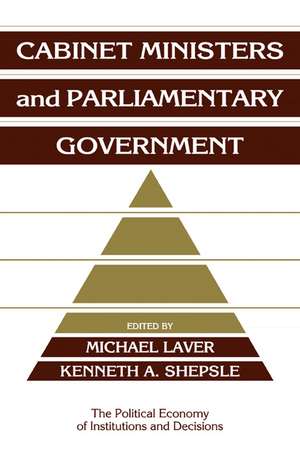Cabinet Ministers and Parliamentary Government: Political Economy of Institutions and Decisions
Editat de Michael Laver, Kenneth A. Shepsleen Limba Engleză Paperback – 29 sep 1994
Din seria Political Economy of Institutions and Decisions
-
 Preț: 235.99 lei
Preț: 235.99 lei -
 Preț: 231.82 lei
Preț: 231.82 lei -
 Preț: 177.53 lei
Preț: 177.53 lei -
 Preț: 211.85 lei
Preț: 211.85 lei -
 Preț: 200.87 lei
Preț: 200.87 lei -
 Preț: 306.68 lei
Preț: 306.68 lei -
 Preț: 208.16 lei
Preț: 208.16 lei -
 Preț: 133.60 lei
Preț: 133.60 lei -
 Preț: 295.55 lei
Preț: 295.55 lei -
 Preț: 236.43 lei
Preț: 236.43 lei -
 Preț: 228.38 lei
Preț: 228.38 lei -
 Preț: 265.11 lei
Preț: 265.11 lei -
 Preț: 281.49 lei
Preț: 281.49 lei -
 Preț: 285.37 lei
Preț: 285.37 lei -
 Preț: 279.98 lei
Preț: 279.98 lei - 14%
 Preț: 773.75 lei
Preț: 773.75 lei -
 Preț: 233.38 lei
Preț: 233.38 lei -
 Preț: 247.41 lei
Preț: 247.41 lei -
 Preț: 203.12 lei
Preț: 203.12 lei -
 Preț: 230.33 lei
Preț: 230.33 lei -
 Preț: 286.69 lei
Preț: 286.69 lei - 14%
 Preț: 790.57 lei
Preț: 790.57 lei -
 Preț: 265.32 lei
Preț: 265.32 lei - 11%
 Preț: 554.15 lei
Preț: 554.15 lei -
 Preț: 287.07 lei
Preț: 287.07 lei - 11%
 Preț: 700.20 lei
Preț: 700.20 lei -
 Preț: 273.13 lei
Preț: 273.13 lei -
 Preț: 459.84 lei
Preț: 459.84 lei -
 Preț: 280.35 lei
Preț: 280.35 lei -
 Preț: 260.11 lei
Preț: 260.11 lei - 11%
 Preț: 640.30 lei
Preț: 640.30 lei -
 Preț: 286.89 lei
Preț: 286.89 lei -
 Preț: 247.80 lei
Preț: 247.80 lei - 11%
 Preț: 691.81 lei
Preț: 691.81 lei -
 Preț: 287.48 lei
Preț: 287.48 lei - 11%
 Preț: 641.80 lei
Preț: 641.80 lei - 11%
 Preț: 635.32 lei
Preț: 635.32 lei -
 Preț: 271.01 lei
Preț: 271.01 lei -
 Preț: 265.70 lei
Preț: 265.70 lei -
 Preț: 227.83 lei
Preț: 227.83 lei
Preț: 263.97 lei
Nou
Puncte Express: 396
Preț estimativ în valută:
50.52€ • 52.55$ • 41.70£
50.52€ • 52.55$ • 41.70£
Carte tipărită la comandă
Livrare economică 15-29 aprilie
Preluare comenzi: 021 569.72.76
Specificații
ISBN-13: 9780521438377
ISBN-10: 0521438373
Pagini: 332
Dimensiuni: 152 x 229 x 19 mm
Greutate: 0.46 kg
Ediția:New.
Editura: Cambridge University Press
Colecția Cambridge University Press
Seria Political Economy of Institutions and Decisions
Locul publicării:New York, United States
ISBN-10: 0521438373
Pagini: 332
Dimensiuni: 152 x 229 x 19 mm
Greutate: 0.46 kg
Ediția:New.
Editura: Cambridge University Press
Colecția Cambridge University Press
Seria Political Economy of Institutions and Decisions
Locul publicării:New York, United States
Cuprins
List of tables and figures; Series editors' preface; Part I. Introduction: 1. Cabinet ministers and government formation in parliamentary democracies Michael Laver and Kenneth A. Shepsle; Part II. Coalition Systems: 2. Models of government and the Australian cabinet Wolfgang C. Müller; 3. The political role of Norwegian cabinet ministers Kaare Strom; 4. The Netherlands: ministers and cabinet policy Rudy B. Andeweg and Wilma Bakema; 5. The political role of cabinet ministers in Ireland Brian Farrell; 6. Finland: ministerial autonomy, constitutional collectivism, and party oligarchy Jaakko Nousiainen; 7. Cabinet ministers and policy-making in Belgium: the impact of coalition constraints Arco Timmermans; 8. The role of cabinet ministers in the French Fourth Republic François Petry; 9. The political autonomy of cabinet ministers in the French Fifth Republic Jean-Louis Thiébault; 10. The role of German ministers in cabinet decision making Ferdinand Müller-Rommel; 11. Cabinet ministers and parliamentary government in Sweden Torbjörn Larsson; 12. The political role of cabinet ministers in Italy Annarita Criscitiello; Part III. Majority Party Government Systems: 13. Ministerial autonomy in Britain Anthony King; 14. Collective cabinet decision making in New Zealand Matthew S. R. Palmer; 15. The interpersonal dynamics of decision making in Canadian provincial cabinets Graham White; 16. Cabinet decision making in the Hellenic Republic 1974–1992 Kleomenis S. Koutsoukis; Part IV. Conclusion: 17. Cabinet government in theoretical perspective Michael Laver and Kenneth A. Shepsle; Index.
Descriere
A close examination of the constitutional relationship between legislature and executive in parliamentary regimes.




















